
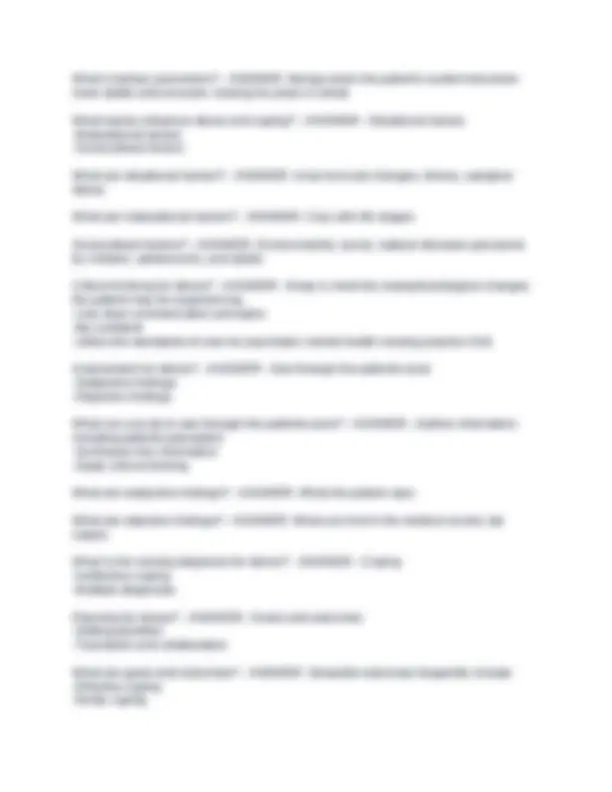
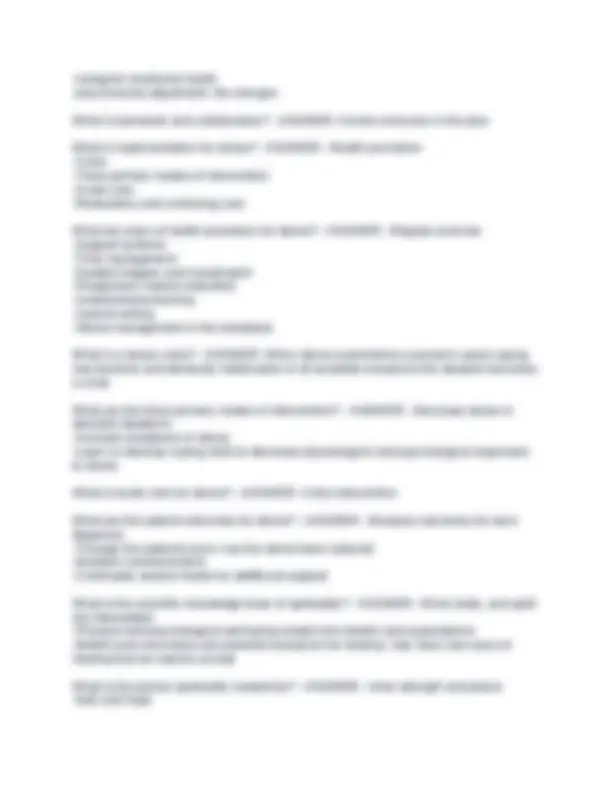
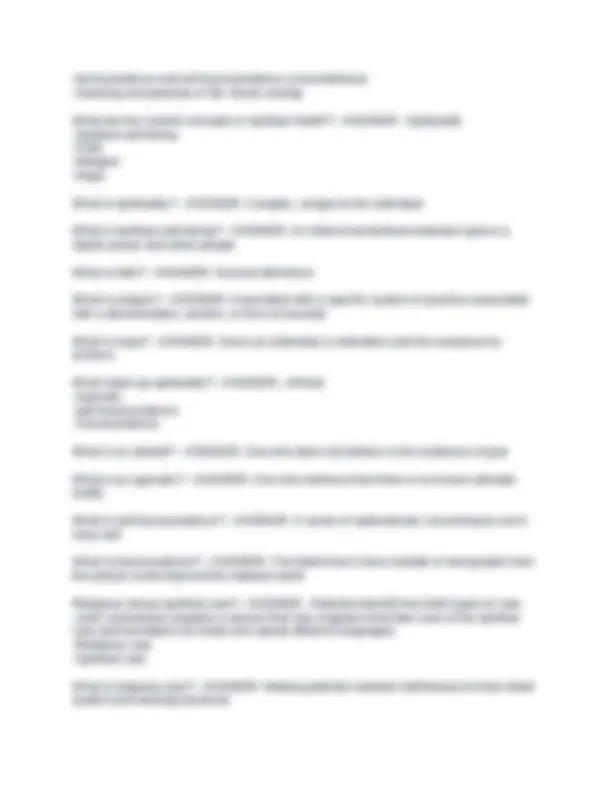
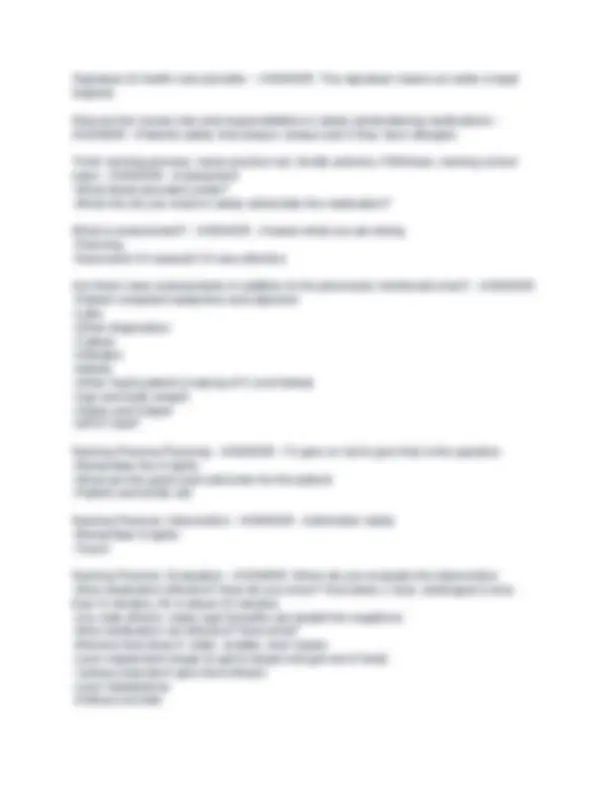
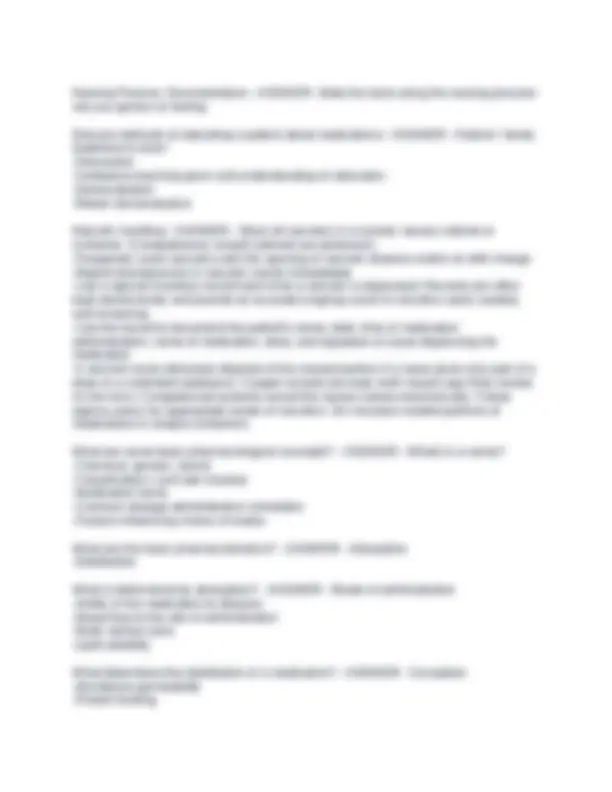
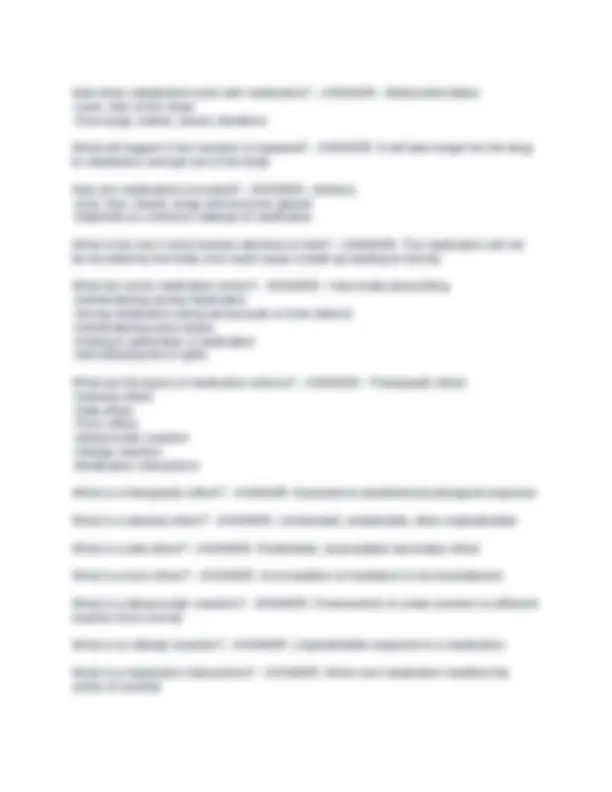
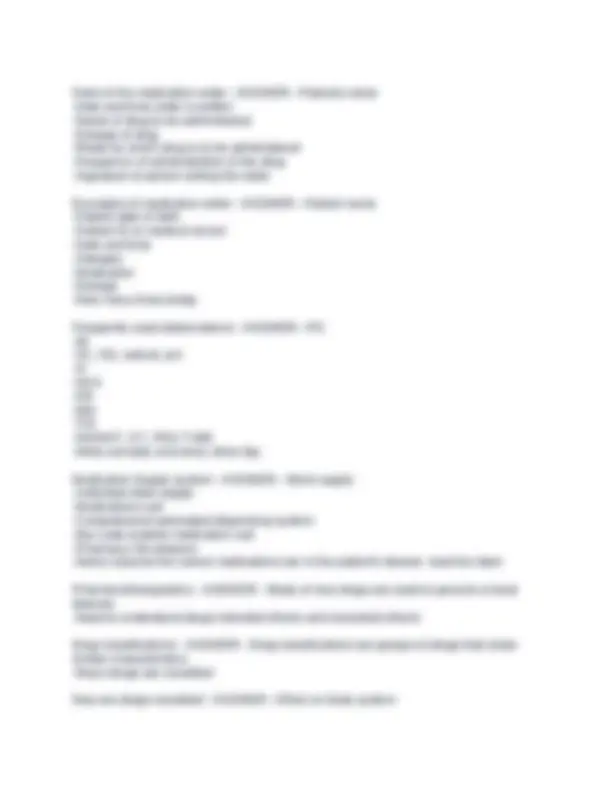

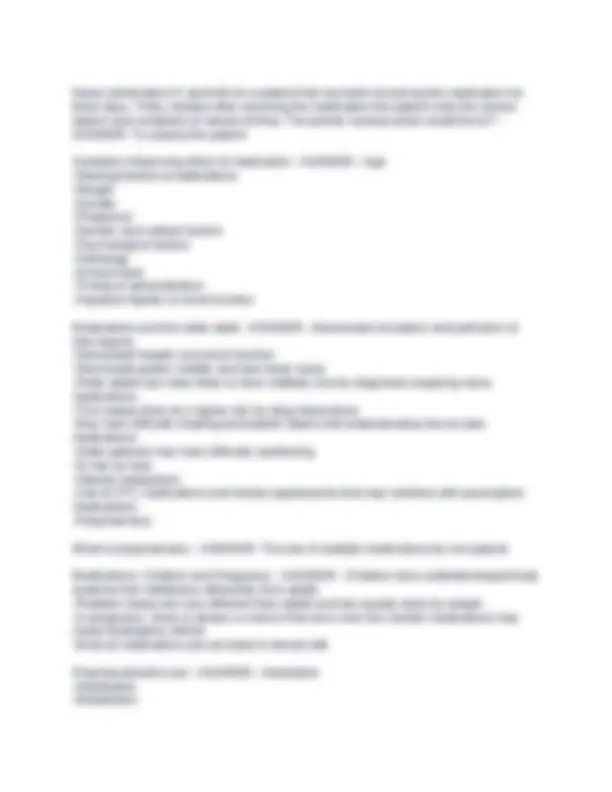


Study with the several resources on Docsity

Earn points by helping other students or get them with a premium plan


Prepare for your exams
Study with the several resources on Docsity

Earn points to download
Earn points by helping other students or get them with a premium plan
Community
Ask the community for help and clear up your study doubts
Discover the best universities in your country according to Docsity users
Free resources
Download our free guides on studying techniques, anxiety management strategies, and thesis advice from Docsity tutors
A comprehensive set of questions and answers related to stress and spirituality in nursing, covering key concepts, theories, and practical applications. It explores the physiological and psychological responses to stress, including the general adaptation syndrome (gas), coping mechanisms, and crisis intervention. The document also delves into the importance of spirituality in healthcare, examining concepts like spiritual well-being, faith, and religious care. It concludes with a section on medication administration, emphasizing the six rights and essential safety protocols.
Typology: Exams
1 / 16

This page cannot be seen from the preview
Don't miss anything!










Scientific knowledge base - ANSWER- -Fight or Flight response -Neurophysiological response What are the neurophysiological responses? - ANSWER- -Medulla oblongata -Reticular formation -Pituitary glad What is the General Adaptation Syndrome (GAS)? - ANSWER- It is an immediate physiological response of the whole body to stress; involves several body systems, especially the autonomic nervous and endocrine systems, and includes immunological changes What are the 3 stage reactions to stress - ANSWER- -Alarm reaction -Resistance stage -Exhaustion stage What is the alarm reaction? - ANSWER- The initial stage What is the resistance stage? - ANSWER- Trying to normalize What is the exhaustion stage - ANSWER- Stay at high level of anxiety What are the parts to psychological stress? - ANSWER- -Primary appraisal -Secondary appraisal -Coping -Ego defense mechanisms What is the primary appraisal? - ANSWER- Evaluating an event for its personal meaning What is the secondary appraisal? - ANSWER- Focuses on possible coping strategies What is coping? - ANSWER- The persons effort to manage psychological stress What is ego defense mechanisms? - ANSWER- They regulate emotional distress and give a person protection from anxiety and stress What are some personal characteristics that influence response to a stressor? - ANSWER- -Level of personal control -Presence of a social support system
-Feelings of competence What are the 3 types of stress? - ANSWER- -Chronic -Acute -PTSD What is chronic stress? - ANSWER- Chronic stress occurs in stable conditions and results from stressful roles What is acute stress? - ANSWER- Time limited events that threaten a person for a relatively brief period provoke acute stress- right now, someone almost hit you What is PTSD? - ANSWER- -An acute stress disorder that begins when a person experiences, witnesses, or is confronted with a traumatic event. -May include flashbacks = recurrent and intrusive recollections of the event What are the 3 types of crises? - ANSWER- -Developmental -Situational -Adventitious what is a developmental crisis? - ANSWER- Developmental crises occur as a person moves through the stages of life- anorexic young person trying to move on- marriage, birth, divorce, retirement, laid off What is a situational crisis? - ANSWER- External sources such as a job change, motor vehicle crash, death or severe illness provoke situational crises. What is adventitious crises? - ANSWER- A major natural or manmade disaster or a crime of violence can create an adventitious crisis-IKE, shootings What is Neuman systems model? - ANSWER- -Based on the concepts of stress and reaction to stress -Nurses develop interventions to prevent or reduce stress on patients or to help them cope- Slowing addition of information to the pile so you don't overload them. What are the three parts to Neuman systems model? - ANSWER- -Primary prevention -Secondary Prevention -Tertiary Prevention What is Primary prevention? - ANSWER- Promotes patient wellness by stress prevention and reduction of risk factors - prevent illness, prevent situations that cause stress. What is secondary prevention? - ANSWER- Occurs after symptoms appear- how to handle once the disease is diagnosed
-caregiver emotional health -psychosocial adjustment: life changes What is teamwork and collaboration? - ANSWER- Involve everyone in the plan What is implementation for stress? - ANSWER- -Health promotion -Crisis -Three primary modes of intervention -Acute care -Restorative and continuing care What are ways of health promotion for stress? - ANSWER- -Regular exercise -Support systems -Time management -Guided imagery and visualization -Progressive muscle relaxation -Assertiveness training -Journal writing -Stress management in the workplace What is a stress crisis? - ANSWER- When stress overwhelms a person's usual coping mechanisms and demands mobilization of all available resources the situation becomes a crisis What are the three primary modes of intervention? - ANSWER- -Decrease stress in stressful situations -Increase resistance of stress -Learn or develop coping skills to decrease physiological and psychological responses to stress What is acute care for stress? - ANSWER- Crisis intervention What are the patient outcomes for stress? - ANSWER- -Measure outcomes for each diagnosis -Through the patients eyes- has the stress been reduced -Maintain communication -Continually assess needs for additional support What is the scientific knowledge base of spirituality? - ANSWER- -Mind, body, and spirit are interrelated -Physical and psychological well-being results from beliefs and expectations -Beliefs and convictions are powerful resources for healing- may have new ways of healing that we need to accept What is the person spirituality created by? - ANSWER- -inner strength and peace -faith and hope
-transcendence and self-transcendence connectedness -meaning and purpose of life -these overlap What are the current concepts in spiritual health? - ANSWER- -Spirituality -Spiritual well-being -Faith -Religion -Hope What is spirituality? - ANSWER- Complex, unique to the individual What is spiritual well-being? - ANSWER- An interconnectedness between god or a higher power and other people What is faith? - ANSWER- Several definitions What is religion? - ANSWER- Associated with a specific system of practice associated with a denomination, section, or form of worship What is hope? - ANSWER- Gives an individual a motivation and the resources to achieve What make up spirituality? - ANSWER- -Atheist -Agnostic -self-transcendence -Transcendence What is an atheist? - ANSWER- One who does not believe in the existence of god What is an agnostic? - ANSWER- One who believes that there is no known ultimate reality What is self-transcendence? - ANSWER- A sense of authentically connecting to one's inner self What is transcendence? - ANSWER- The belief that a force outside of and greater than the person exists beyond the material world Religious versus spiritual care? - ANSWER- -Patients benefit from both types of care -Joint commission requires a service that has chaplains that take care of the spiritual care and translators for those who speak different languages -Religious care -Spiritual care What is religious care? - ANSWER- Helping patients maintain faithfulness to their belief system and worship practices
When should the nurse document the medication was given? - ANSWER- After you give the meds What are some of the other rights? - ANSWER- -Patient rights -To be informed -To refuse -Right to have qualified nurses or providers manage their medications -Documentation of medication administration What are the components of medication orders? - ANSWER- A medication order is incomplete unless it has the following parts: -Patients full name -Date and time that the order is written -Medication name -Dose -Route of administration -Time and frequency of administration -Signature of health care provider Patients full name - ANSWER- The patients full name distinguishes the patient from other persons with the same last name. In the acute care setting patients are sometimes assigned special identification numbers (ex. Medical record number) to help distinguish patients with the same names. This number is often included on the order form. Date and time that the order is written: - ANSWER- The day, month, year, and time need to be included. Designating the time that an order is written helps clarify when certain orders are to start and stop. If an incident occurs involving a medication error, it is easier to document what happened when this information is available. Medication name: - ANSWER- The health care provider orders a medication by its generic or trade name. Correct spelling is essential in preventing confusion with medications with similar spelling. Dose: - ANSWER- The amount or strength of the medication is included Route of administration: - ANSWER- The health care provider uses accepted abbreviations for medication routes. Accuracy is important to ensure that patients receive medications by the intended route. Time and frequency of administration: - ANSWER- The nurse needs to know what time and how frequently to administer medications. Orders for multiple doses establish a routine schedule for medication administration.
Signature of health care provider: - ANSWER- The signature makes an order a legal request. Discuss the nurses role and responsibilities in safely administering medications - ANSWER- -Patients safety first always- always ask if they have allergies Think nursing process, nurse practice act, facility policies, FDN/laws, nursing school rules - ANSWER- -Assessment -What about providers order? -What info do you need to safely administer the medication? What is assessment? - ANSWER- -Assess what you are doing -Planning -Document if it worked/ if it was effective Are there more assessments in addition to the previously mentioned ones? - ANSWER- -Patient complaint subjective and objective -Labs -Other diagnostics -Culture -Allergies -History -Other meds patient is taking oTC and Herbal -Age and body weight -Intake and Output -NPO? Diet? Nursing Process:Planning - ANSWER- -To give or not to give that is the question -Remember the 6 rights -What are the goals and outcomes for the patient -Patient and family will Nursing Process: Intervention - ANSWER- -Administer safely -Remember 6 rights -Teach Nursing Process: Evaluation - ANSWER- When do you evaluate the intervention -Was medication effective? How do you know? Oral takes 1 hour, sublingual is less than 5 minutes, IM is about 15 minutes -Any side effects- make sure benefits out weight the negatives -Was medication not effective? Now what? -Receive less dose if: older, smaller, liver issues -Liver impairment longer to get to target and get out of body
How does metabolism work with medication? - ANSWER- -Biotransformation -Liver- star of the show -Also lungs, kidney, blood, intestines What will happen if live function is impaired? - ANSWER- It will take longer for the drug to metabolize and get out of the body. How are medications excreted? - ANSWER- -kidneys -Also, liver, bowel, lungs and exocrine glands -Depends on chemical makeup of medication What is the risk if renal function declines or fails? - ANSWER- The medication will not be excreted by the body and could cause a build up leading to toxicity What are some medication errors? - ANSWER- -Inaccurate prescribing -Administering wrong medication -Giving medication using wrong route or time interval -Administering extra doses -Failing to administer a medication -Not following the 6 rights What are the types of medication actions? - ANSWER- -Therapeutic effect -Adverse effect -Side effect -Toxic effect -Idiosyncratic reaction -Allergic reaction -Medication interactions What is a therapeutic effect? - ANSWER- Expected or predicted physiological response What is a adverse effect? - ANSWER- Unintended, undesirable, often unpredictable What is a side effect? - ANSWER- Predictable, unavoidable secondary effect What is a toxic effect? - ANSWER- Accumulation of mediation in the bloodstream What is a idiosyncratic reaction? - ANSWER- Overreaction or under reaction or different reaction from normal What is an allergic reaction? - ANSWER- Unpredictable response to a medication What is a medication interactions? - ANSWER- When one medication modifies the action of another
Medication reconciliation - ANSWER- -Define and just do it -Comparing the medication the patient took in previous setting to now and orders for now -Communicating meds patient taking on your unit to patients new destination -Make sure all is right and matches- consult with who to be sure -Do this without distraction Medication orders more safety and legalities - ANSWER- -Receiving, transcribing, communicating medication orders -Follow agency policy and current national patient safety standards -Nursing students are prohibited from receiving verbal and telephone orders Types of orders in acute care agencies - ANSWER- -Standing or routine -PRN -Single/one time -STAT -Now -Prescription/orders PRN is - ANSWER- as needed Phones orders are? - ANSWER- Repeated back and have 2 nurses listening STAT is - ANSWER- asap Now is - ANSWER- within 30 minutes What is a medication? - ANSWER- - A substance administered for the diagnosis, cure, treatment or relief of a symptom or for the prevention of disease -Medications modify bodily functions when taken in by the body -The term drug and medication may be used interchangeably Drug nomenclature - ANSWER- -Chemical name -Generic name -Official name -Trade name What is a chemical name - ANSWER- Identifies drugs atomic and molecular structure What is a generic name? - ANSWER- Assigned by the manufacturer that first develops the drug What is a official name? - ANSWER- Name by which the drug is identified in official publications USP and NF
Parts of the medication order - ANSWER- -Patients name -Date and time order is written -Name of drug to be administered -Dosage of drug -Route by which drug is to be administered -Frequency of administration of the drug -Signature of person writing the order Examples of medication order - ANSWER- -Patient name -Patient date of birth -Patient ID or medical record -Date and time -Allergies -Medication -Dosage -How many times today Frequently used abbreviations - ANSWER- -PO -IM -SC, SQ, subcut, prn -IV -HAS -PR -BID -TID -NG/NGT, GT, PEG TUBE -Write out daily and every other day Medication Supply system - ANSWER- -Stock supply -Individual dose supply -Medications cart -Computerized automated dispensing system -Bar code enables medication cart -Pharmacy fills drawers -Never assume the correct medications are in the patient's drawer- read the label Pharmacotherapeutics - ANSWER- -Study of how drugs are used to prevent or treat disease -Need to understand drugs intended effects and unwanted effects Drug classifications - ANSWER- -Drug classifications are groups of drugs that share similar characteristics -Ways drugs are classified How are drugs classified - ANSWER- -Effect on body system
-Chemical composition -Clinical indications or therapeutics action Effects of medications - ANSWER- -Desired effect -Side effects -Adverse reactions -Idiosyncratic response -Drug Interactions What is a desired effect? - ANSWER- The intended or expected clinical response to the drug What is a side effects? - ANSWER- Physiological effects not related to desirable effects What is a adverse reaction? - ANSWER- Any unintended response to a drug that occurs when the therapeutics dose is administered- more severe than side effects What is a idiosyncratic response - ANSWER- Genetically determined abnormal or excessive response to a drug What is a drug interaction? - ANSWER- One drug alters the pharmacokinetics of another drug- can cause drug toxicity Allergic reactions - ANSWER- -Allergic reaction -Hypersensitivity reaction -Manifestions -May be treated with antihistamines (most commonly benadryl) and corticosteriods What is an allergic reaction - ANSWER- Adverse responses that results from previous exposure to the same drug or one chemically similar What is an hypersensitivity reaction? - ANSWER- The patients immune system acts as if the drug is an invader What is a manifestation? - ANSWER- Rash, urticaria, fever, N/V, diarrhea, angio edema, photosensitivity Anaphylactic reaction - ANSWER- -Immediate hypersensitivity response -More severe and life threatening if it is in response to the administration of IV medications -Urticaria, pruritus, angio edema -Untreated may lead to shock -Life threatening hypotension and airway involvement -Treatment involves management of airways issues that may require intubation -Steroids, antihistamines, epinephrine -Management of hypotension
-Excretion What is absorption - ANSWER- Drug is transferred from site of entry into the bloodstream What is distribution - ANSWER- Drug is distributed throughout the body What is metabolism - ANSWER- Drug is broken down into an inactive form What is excretion - ANSWER- Drug is excreted from the body What are some factors affecting drug absorption - ANSWER- -Route of administration -Lipid solubility -pH -blood flow -local conditions at the site of administration -drug dosage -Serum drug levels -Concurrent administration